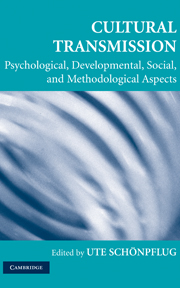Book contents
- Frontmatter
- Contents
- Foreword
- Contributors
- 1 Introduction to Cultural Transmission: Psychological, Developmental, Social, and Methodological Aspects
- 2 Theory and Research in Cultural Transmission: A Short History
- PART ONE EVOLUTIONARY PERSPECTIVE
- PART TWO CROSS-CULTURAL PERSPECTIVE
- PART THREE INTRACULTURAL VARIATIONS
- 14 Intergenerational Transmission of Moral Capital across the Family Life Course
- 15 Similarity of Life Goals in the Family: A Three-Generation Study
- 16 The Intergenerational Transmission of Xenophobia and Rightism in East Germany
- 17 Intergenerational Transmission of Violence
- 18 “Don't Trust Anyone over 25”: Youth Centrism, Intergenerational Transmission of Political Orientations, and Cultural Change
- 19 Value Transmission and Zeitgeist Revisited
- 20 Epilogue: Toward a Model of Cultural Transmission
- Index
- References
20 - Epilogue: Toward a Model of Cultural Transmission
Published online by Cambridge University Press: 05 June 2012
- Frontmatter
- Contents
- Foreword
- Contributors
- 1 Introduction to Cultural Transmission: Psychological, Developmental, Social, and Methodological Aspects
- 2 Theory and Research in Cultural Transmission: A Short History
- PART ONE EVOLUTIONARY PERSPECTIVE
- PART TWO CROSS-CULTURAL PERSPECTIVE
- PART THREE INTRACULTURAL VARIATIONS
- 14 Intergenerational Transmission of Moral Capital across the Family Life Course
- 15 Similarity of Life Goals in the Family: A Three-Generation Study
- 16 The Intergenerational Transmission of Xenophobia and Rightism in East Germany
- 17 Intergenerational Transmission of Violence
- 18 “Don't Trust Anyone over 25”: Youth Centrism, Intergenerational Transmission of Political Orientations, and Cultural Change
- 19 Value Transmission and Zeitgeist Revisited
- 20 Epilogue: Toward a Model of Cultural Transmission
- Index
- References
Summary
INTRODUCTION
This epilogue provides some afterthoughts to the wealth of ideas in the chapters collected for this volume. It provides a summary of the main ideas, theoretical approaches, and results presented by putting together what is already in place and – to a greater extent – what is still needed to develop an integrated theoretical model of transmission. It may well be that this goal will not be reached, and research and theorizing is not sufficiently far advanced to decide whether the efforts invested were worth the time. Nevertheless, that which has been achieved in various disciplines to clarify the mechanisms and results of cultural transmission processes seems promising. We know some of the fundamental transmission mechanisms and transmission belts. However, there are more to discover and we have to clarify the conditions for the transmission gap (Fox, 1995) – that is, the lack of reproductive transfer of social orientations, skills, and knowledge across generations and peers.
THE CULTURAL EVOLUTIONARY PERSPECTIVE
Selectivity of Transmission
The most challenging issues for transmission research and theory to emerge from the framework of cultural evolution are certainly the following questions: What causes the differential transmission of cultural elements or traits? Which factors are responsible for the relatively high transmissibility of some elements and the relatively low transmissibility of others?
- Type
- Chapter
- Information
- Cultural TransmissionPsychological, Developmental, Social, and Methodological Aspects, pp. 460 - 478Publisher: Cambridge University PressPrint publication year: 2008
References
- 1
- Cited by



